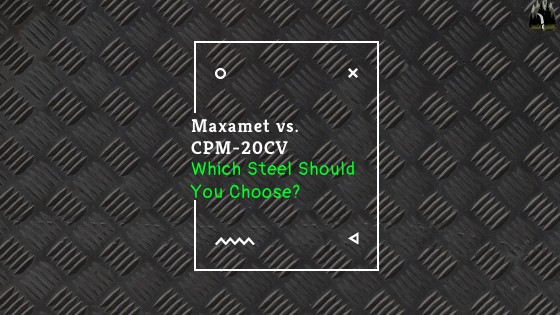Maxamet and CPM-20CV are two premium steels that are great choices for knife steels–if you can afford them. In this article, we’re doing a deepdive into which one is better and why.
Here’s the short answer:
Maxamet and CPM-20CV are both premium steels, but Maxamet is made almost exclusively for edge retention. CPM-20CV has better corrosion resistance, ease of sharpening, and toughness. If you need something for slicing tasks, Maxamet is better. Otherwise, choose CPM-20CV.
With the short answer out of the way, let’s take a closer look at each steel.
Deep dive on Maxamet
Maxamet is a relatively new steel that was developed by Carpenter Technology. It is known for having great edge retention, but being too great at anything else. Maxamet’s steel composition is proprietary, but it’s believed to be something like the following:
- 2.15% carbon,
- 4.75% chromium,
- 10% cobalt,
- 0.3% manganese,
- 13% tungsten, and
- 6% vanadium.
Carbon helps to improve wear resistance and strength (though too much carbon can lead to brittleness). Chromium helps with corrosion resistance, but Maxamet has a fairly low chromium content, which means it’s not very corrosion resistant. Cobalt, tungsten, manganese, and vanadium all help increase the strength and wear resistance of the steel.
Maxamet’s known for having extreme edge retention, but not being too good in any other segment. Having great edge retention usually comes from the blade having high hardness, which means that Maxamet can be susceptible to chipping. It’s also pretty expensive because of the complex manufacturing process used to make it.
Deep dive on CPM-20CV
CPM-20CV is a high-performance steel that was developed by Crucible Industries. It’s made using a process called “Crucible Particle Metallurgy,” which is keeps the grain size of the blade small. This means that the steel is more consistent and less likely to suffer from breaks or other complete failures.
CPM-20CV has the following composition:
- 1.9% carbon
- 20% chromium
- 1% molybdenum
- 4% vanadium
- 1% tungsten
CPM-20CV has molybdenum (Maxamet does not), which makes the knives easier to harden, which makes it easier to manufacture.
Maxamet versus CPM-20CV
Maxamet is basically exclusively made for slicing tasks. It has excellent edge retention, but lacks in pretty much every other department. It is especially poor in corrosion resistance. So, if you work in a humid environment, either keep your Maxamet well-oiled or look for a different knife steel.
CPM-20CV on the other hand, has decent edge retention, ease of sharpening, and toughness, but it’s got great corrosion resistance. If you need something that can withstand a little bit more punishment and is more well-rounded, CPM-20CV is the better option.
Recommended Knives
Here are our favorite knives in each steel.
Spyderco Para Military 2 – Maxamet
The Spyderco Para Military 2 is one of the most popular knives out there. It’s a workhorse of a knife with G-10 handle scales, a thumbhole opening, Spyderco’s smooth-closing compression lock, and with this version, has the super steel Maxamet. The Maxamet steel turns this knife from good to great.
Check it out here (link to Amazon).
Zero Tolerance 0308 – CPM-20CV
Zero Tolerance is made by the same parent company that makes Kershaw knives, so you might see some similarities there if you’re familiar with Kershaw. The 0308 has a G10 handle scale with a titanium back, 20CV steel, a reversible pocket clip, a flipper for opening, and a ball bearing pivot that makes for smooth opening.
Check it out here (link to Amazon).
Conclusion
Overall, both Maxamet and CPM-20CV are great steels, but they are used for vastly different applications. If you need to do a lot of slicing, Maxamet is by far the better option (just keep it oiled if you’re in a humid environment). Otherwise, check out 20CV, as it’s more well-rounded.
If you’d like to see more articles about knives, click here.

